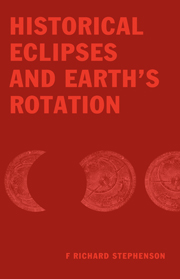Book contents
- Frontmatter
- Contents
- Principal Symbols
- 1 Variations in the length of the day: a historical perspective
- 2 Tidal friction and the ephemerides of the Sun and Moon
- 3 Pre-telescopic eclipse observations and their analysis
- 4 Babylonian and Assyrian records of eclipses
- 5 Investigation of Babylonian observations of solar eclipses
- 6 Timed Babylonian lunar eclipses
- 7 Untimed Babylonian observations of lunar eclipses: horizon phenomena
- 8 Chinese and other East Asian observations of large solar eclipses
- 9 Other East Asian observations of solar and lunar eclipses
- 10 Records of eclipses in ancient European history
- 11 Eclipse records from medieval Europe
- 12 Solar and lunar eclipses recorded in medieval Arab chronicles
- 13 Observations of eclipses by medieval Arab astronomers
- 14 Determination of changes in the length of the day
- Appendix A Timed data
- Appendix B Untimed data
- References
- Acknowledgements
- Index of eclipse records
- Index of places of observation
- Name Index
- Subject index
4 - Babylonian and Assyrian records of eclipses
Published online by Cambridge University Press: 13 November 2009
- Frontmatter
- Contents
- Principal Symbols
- 1 Variations in the length of the day: a historical perspective
- 2 Tidal friction and the ephemerides of the Sun and Moon
- 3 Pre-telescopic eclipse observations and their analysis
- 4 Babylonian and Assyrian records of eclipses
- 5 Investigation of Babylonian observations of solar eclipses
- 6 Timed Babylonian lunar eclipses
- 7 Untimed Babylonian observations of lunar eclipses: horizon phenomena
- 8 Chinese and other East Asian observations of large solar eclipses
- 9 Other East Asian observations of solar and lunar eclipses
- 10 Records of eclipses in ancient European history
- 11 Eclipse records from medieval Europe
- 12 Solar and lunar eclipses recorded in medieval Arab chronicles
- 13 Observations of eclipses by medieval Arab astronomers
- 14 Determination of changes in the length of the day
- Appendix A Timed data
- Appendix B Untimed data
- References
- Acknowledgements
- Index of eclipse records
- Index of places of observation
- Name Index
- Subject index
Summary
Introduction
More celestial observations are preserved from Babylon than from any other contemporary civilisation. Yet until about a century ago, when large numbers of clay tablets devoted to astronomy began to be unearthed at the site of Babylon, little was known about the achievements of the skywatchers of this once great city. What could be established was mainly based on ancient Greek texts and the Old Testament. Both the Prophet Isaiah (e.g. 47:13) and the ancient Greek writer Strabo (Geography, XVI, 1.6) stress the Babylonian preoccupation with astrology. As noted in chapter 3, the ancient Greek historian Diodorus Siculus (Library of History, II, 9) implies that the lofty ziggurat – built during the reign of Nebuchadrezzar II (604–563 BC) was used as an observatory. Figure 4.1 shows a schematic view of Babylon in the days of Nebuchadrezzar II – as visualised by Herbert Anger (Unger, 1931, figure 7).
Among writers of the ancient Greek and Roman world whose works are still extant, only the great Alexandrian astronomer Claudius Ptolemy (c. AD 150) hints at the true scale on which celestial observation was practised at Babylon. In his Mathematike Syntaxis (Mathematical Systematic Treatise) – which later became known as the Almagest – Ptolemy specifically mentions sets of Babylonian eclipse observations to which he had access. Examples of his comments are as follows:
(i) First, the three ancient eclipses which are selected from those observed in Babylon…
[Almagest, IV, 6; trans. Toomer (1984, p. 191).]- Type
- Chapter
- Information
- Historical Eclipses and Earth's Rotation , pp. 93 - 127Publisher: Cambridge University PressPrint publication year: 1997



